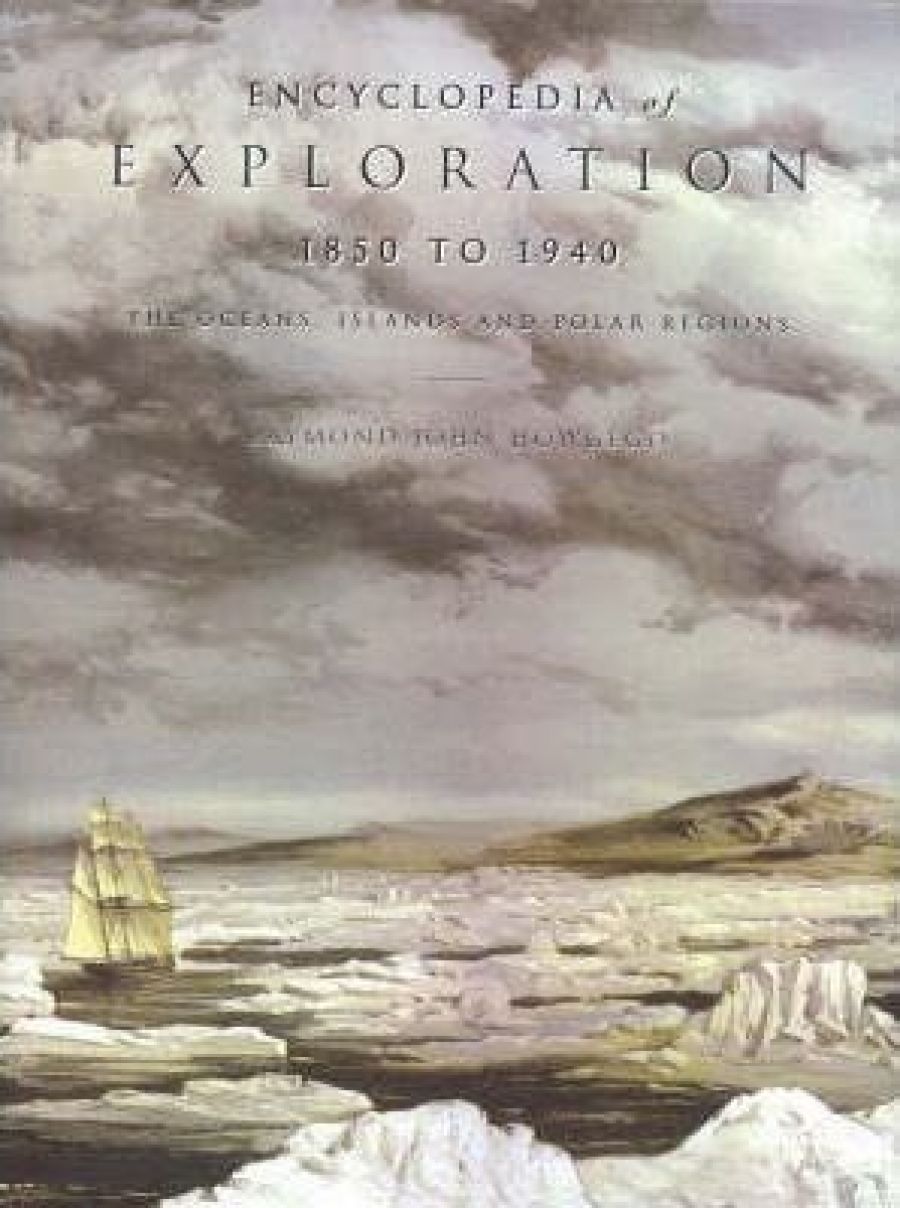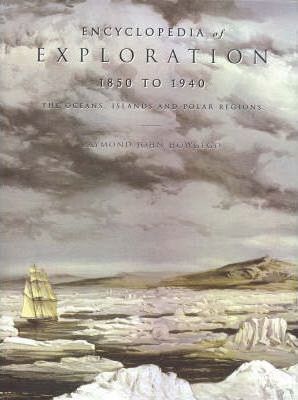
- Free Article: No
- Contents Category: History
- Review Article: Yes
- Article Title: Is your journey really necessary?
- Online Only: No
- Custom Highlight Text:
When does an explorer become an adventurer, an adventurer a traveller, a traveller a tourist? This third volume of Raymond Howgego’s monumental Encyclopedia of Exploration moves into a period when the lines become increasingly blurred.
Volume One (2003) covered all of human history up to 1800. In that period, any traveller who left a written account of his or her journey could be counted as an ‘explorer’, and Howgego’s sheer stamina in seeking them all out made this one of the extraordinary books of our time. Most reference works of this scale are assembled by small armies of writers, researchers and editors, funded by major international publishers. The Encyclopedia of Exploration to 1800 was the work of one man, supported by the comparatively modest resources of Sydney antiquarian bookseller and boutique publisher, Hordern House.
- Book 1 Title: Encyclopedia of Exploration, 1850–1940
- Book 1 Subtitle: The oceans, islands and polar regions
- Book 1 Biblio: Hordern House, $245 hb, 724 pp
- Book 1 Cover Small (400 x 600):

- Book 1 Cover (800 x 1200):

The massive technological changes of the nineteenth century made the period since 1800 much more complicated. Suddenly, neither travelling nor writing about travelling was such an unusual thing. Howgego’s second volume (2005), covering 1800 to 1850, was much more selective in its coverage than its precursor – and with selectivity comes the dangers of ambiguity and inconsistency. With Volume Three, the problems multiply. In order to arrive at a date when the surface of the earth had been mapped in consistent detail, Howgego extended his coverage to 1940. The projected single volume was then split into two along geographical lines. This new volume covers exploration of ‘oceans, islands and polar regions’. Volume Four will deal with ‘continental’ exploration.
All of these decisions have combined to make Volume Three the most problematic of the series. The end date of 1940 looks arbitrary: Howgego notes that ‘the exploration of New Guinea … even by then had been only partially completed’, that ‘the exploration of New Zealand … required consideration only to 1900’, that ‘other islands might be detailed into the 1920s’, and that ‘pioneering flights in the polar regions … by virtue of their significance in the history of exploration, are fully documented, regardless of date’.
Volumes One and Two are largely devoted to entries for individual explorers. Volume Three contains numerous articles on places and regions, raising further questions about the basis of selection. There are entries for the Andaman Islands, the Chatham Islands, the Cook Islands, Easter Island, Fiji, Greenland, Hawaii, ‘Korea and the Sea of Japan’, Madagascar, Micronesia, Pitcairn Island, Réunion, South Georgia, Spitsbergen, Sri Lanka and many more. There are also two lengthy entries on aviation (one dealing with balloons, dirigibles and airships, the other with aeroplanes), and one on ‘Telegraph Cables, submarine and overland’: these entries alone might stand as summaries of the technological developments that changed the very nature and meaning of ‘exploration’ during the period covered by this volume.
These overview entries are all good. They will earn Howgego the status of ‘standard introduction’ as well as ‘standard reference’. The problem is that there are not more of them in earlier volumes. You can go to Howgego for a soundly detailed account of Borneo, but you will search in vain for a similar overview of the Philippines.
What, in any case, is an ‘island’? Expeditions into the New Guinea highlands, or New Zealand’s Southern Alps, would seem to have more in common with ‘continental’ exploration than with the charting of Lord Howe Island.
Then there is the difficulty of establishing selection criteria for individuals. Volume Three devotes entries to such adventurous travellers as American journalist Maturin Ballou (a sort of nineteenth-century Paul Theroux), globetrotting French aristocrat Ludovic de Beauvoir and Irish-Australian novelist Beatrice Grimshaw. Popular as their books were, it is difficult to argue that they made original contributions to human knowledge of the physical world, unless it was by bringing that knowledge to a popular audience. Artist Paul Gaugin also gets his own entry, the list of references for which includes W. Somerset Maugham’s novel The Moon and Sixpence (1919). There is an entry, too, for Charles Chiniquy, whose tour of Australia generated not just a ‘narrative’ but sectarian riots in practically every town and city he visited.
Travellers who visited both ‘continents’ and ‘islands’ present particular problems. Isabella Bird, for example, is probably more notable for her journeys in Tibet and for her involvement with British military reconnaissance in the Middle East than for her visits to Hawaii and Japan, but she is included in the ‘oceans, islands and polar regions’ volume by virtue of the latter. An alphabetical (A–L, M–Z) split would have avoided conundrums like this.
It is to be hoped that these issues will matter less when the final volume appears. The great strength of Howgego’s work is his inclusiveness, the very thing that opens him up to charges of inconsistency.
By reaching into the middle of the twentieth century, Howgego’s work has become much more than a compendium of facts. Closing in on living memory, it reminds us just how recently we have come to take for granted our capacity to travel wherever and whenever we want – and in safety, too, if not in style and comfort. Many destinations have remained exotic, but over a mere two or three generations the act of travelling itself has been normalised. In 1940 W.H. Auden imagined an explorer lost in the desert as an ‘average man attempting the exceptional’ (‘The Quest’); by the 1970s the same man in the same location might still have been heroic (an aid worker, perhaps), but far from exceptional.
Another generation on, events are converging once again to make long distance travel difficult, expensive and dangerous. Petroleum production is expected to peak in 2010. The recent price rises have given us a taste of what real shortages might mean. Over the past half-century, we have built our suburbs and our working lives on the motor car. Major cities are now seeing a significant rise in commuter numbers on public transport. Take this a few steps further, and mix in the changes that terrorism has brought and that global warming promises.
I am writing this on the fifth anniversary of the terrorist attacks that destroyed the World Trade Centre. With every near miss since, airline security has been tightened. And it isn’t just airlines: ‘security’ in all areas of life has been increased; standards of privacy and trustfulness that seemed inviolable just a few years ago now look unworldly, dangerously slack. The day after I signed up to review this book, the Weekend Australian magazine ran a story on ‘global risk’ training for business travellers (12–13 August 2006). Presumably, international business and government travel is subject to rigorous risk/benefit analysis. But just how invasive can security measures become before a critical mass of recreational travellers decide to stay at home? Even if petroleum reserves were infinite, the era – the fleeting historical moment – of mass international travel might be drawing to a close.
More importantly, as Al Gore is now reminding us, there are greater dangers than terrorist attacks. As ice caps melt and the sea level rises, as storms become more violent, summer and winter temperatures more extreme, floods more frequent on one side of the world, and droughts more protracted on the other – if even a few of these predictions of climate change are fulfilled, how long will it be until the world of Howgego’s explorers is altered beyond recognition?


Comments powered by CComment